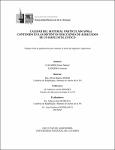Mostrar el registro sencillo del ítem
Calidad del material particulado (pm10) contenido en las distintas fracciones de agregados de un Haplustol Entico
| dc.contributor.advisor | Aimar, Silvia Beatriz | |
| dc.contributor.advisor | Mendez, Mariano Javier (co-director) | |
| dc.contributor.author | Colombo, Denis Nahuel | |
| dc.contributor.author | Ledesma, Gonzalo | |
| dc.contributor.other | Quiroga, Alberto Raúl (jurado) | |
| dc.contributor.other | Panebianco, Juan Esteban (jurado) | |
| dc.date.accessioned | 2020-09-28T16:32:56Z | |
| dc.date.available | 2020-09-28T16:32:56Z | |
| dc.date.issued | 2017 | |
| dc.identifier.uri | https://repo.unlpam.edu.ar/handle/unlpam/1465 | |
| dc.description.abstract | Conocer la composición química del material respirable (partículas con diámetro aerodinámico inferior a 10 micrones) es relevante debido a su relación con la salud humana y el ciclo de los elementos. Resulta de interés conocer el contenido de glifosato en el material respirable emitido por suelos agrícolas, debido al amplio uso de este herbicida en los últimos tiempos en Argentina. El objetivo de este estudio fue caracterizar la calidad del material particulado emitido por las diferentes fracciones de agregados de un Haplustol Entico bajo manejo agrícola ganadero con historia de aplicación de agroquímicos, en la Región Semiárida Pampena Central. Se tomaron 3 muestras compuestas por 3 submuestras de los primeros 2 cm del suelo, a las cuales se le realizaron distintas determinaciones analíticas para conocer la composición físico-química de los agregados del suelo y del material particulado colectado. Los resultados indicaron que las PM10 emitidas por las fracciones de agregados analizadas poseen similares concentraciones de Glifosato las cuales variaron entre 11 y 20 µg kg-1 y las concentraciones de su principal metabolito el ácido aminometil-fosfónico (AMPA) que fluctuaron entre 527,4 y 746,2 µg kg-1. No se encontraron relaciones entre contenido de glifosato y los contenidos de arcilla, limo y materia orgánica tanto en las fracciones de agregados como en el material particulado colectado de dichas fracciones. Finalmente se concluye que el material respirable emitido por el suelo y sus fracciones presentan contenidos de glifosato y AMPA similares entre si y mayores a los del suelo y fracciones de agregados. | |
| dc.description.abstract | Know the chemical composition of the respirable material (particles with aerodynamic diameter less than 10 microns) is relevant due to its relation with human health and the cycle of the elements. It is interesting to know the content of glyphosate in the respirable material emitted by agricultural soils, due to the extensive use of this herbicides in recent times in Argentina. The objective of this study was characterize the quality of the particulate material emitted by the different fractions of aggregate of an Haplustoll Entic under agricultural cattle management, with a history of application of agrochemicals, in the central semi - arid region of La Pampa. Three samples were taken, consisting of 3 subsamples of the first 2 cm of the soil, to which different analytical determinations were made to know the physicochemical composition of the aggregates of the soil and of the collected particulate material. The results indicated that the PM10 emitted by the aggregate fractions analyzed had similar Glyphosate concentrations ranging from 11 to 20 µg kg-1 and the concentrations of their main metabolite, aminomethyl phosphonic acid (AMPA), which fluctuated between 527.4 and 746.2 µg kg-1. No relationships were found between glyphosate content and clay, silt and organic matter contents in both, the aggregate fractions and the particulate matter collected from these fractions. Finally we concluded that the respirable material emitted by the soil and its fractions present similar contents of glyphosate and AMPA, and greater than those of the soil and fractions of aggregates. | |
| dc.format.medium | application/pdf | |
| dc.language.iso | spa | |
| dc.rights | Atribución-NoComercial-CompartirIgual 2.5 Argentina (CC BY-NC-SA 2.5 AR) | |
| dc.rights.uri | https://creativecommons.org/licenses/by-nc-sa/2.5/ar/ | |
| dc.subject.other | Agricultura : : Suelos | |
| dc.title | Calidad del material particulado (pm10) contenido en las distintas fracciones de agregados de un Haplustol Entico | |
| dc.type | tesis | |
| dc.unlpam.subtype | trabajo final | |
| dc.unlpam.grado | Ingeniero Agrónomo | |
| dc.unlpam.carrera | Ingeniería Agronómica | |
| dc.unlpam.instituciondeorigen | Facultad de Agronomía | |
| dc.unlpam.access | openAccess | |
| dc.unlpam.version | acceptedVersion | |
| dc.unlpam.filiacion | Colombo, Denis Nahuel. Universidad Nacional de La Pampa; Argentina. | |
| dc.unlpam.filiacion | Ledesma, Gonzalo. Universidad Nacional de La Pampa; Argentina. | |
| dc.unlpam.filiacion | Aimar, Silvia Beatriz. Universidad Nacional de La Pampa; Argentina. | |
| dc.unlpam.filiacion | Mendez, Mariano Javier. Universidad Nacional de La Pampa; Argentina. | |
| dc.unlpam.filiacion | Quiroga, Alberto Raúl. Universidad Nacional de La Pampa; Argentina. | |
| dc.unlpam.filiacion | Panebianco, Juan Esteban. Instituto de Ciencias de la Tierra y Ambientales de La Pampa; Argentina. | |
| dc.subject.keyword | Respirable dust | |
| dc.subject.keyword | Glyphosate | |
| dc.subject.keyword | AMPA | |
| dc.subject.keyword | Wind erosion | |
| dc.subject.palabraclave | Material Respirable | |
| dc.subject.palabraclave | Glifosato | |
| dc.subject.palabraclave | AMPA | |
| dc.subject.palabraclave | Erosión Eólica |
Ficheros en el ítem
Este ítem aparece en la(s) siguiente(s) colección(ones)
-
Tesisg [1852]











